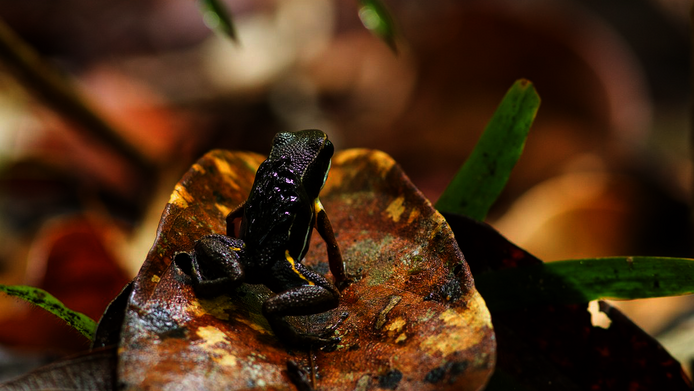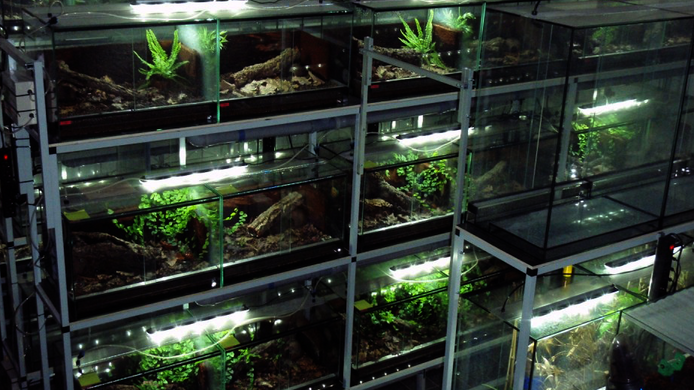From cannibal to model father

They measure between 1.5 and 6 centimetres in length; their skin is often brightly coloured and poisonous. They live in Central and South America and are very different from the rest of their kind. The creatures we are talking about here are poison dart frogs. Unlike many other frogs, they are active during the day, display highly territorial behaviour and lay their eggs on land. The tadpoles, however, which hatch a few weeks after the eggs have been laid, can survive only in water. The poison dart frogs solve this dilemma - terrestrial egg-laying and aquatic tadpoles – by putting a great deal of effort into brood care: the frog parents carry the freshly hatched tadpoles piggy-back to suitable pools of water - a decidedly atypical behaviour for frogs.
Poison dart frogs are strategic planners
Ever since she wrote her diploma thesis, Eva Ringler has been fascinated by the enormous variety of mating and breeding behaviour shown by this group of frogs. Contrary to the received wisdom that amphibians are highly instinctive, her work has shown that poison dart frogs can engage in strategic planning and flexibly adapt their behaviour to changing conditions. Ringler, a biologist at the Messerli Research Institute at the Vienna University of Veterinary Medicine, is investigating Allobates femoralis, a non-toxic representative within the poison dart frog family with a brown-coloured skin and a light stripe down its sides, which is widespread in Amazonia and the Guyana shield.
Dedicated fathers
With poison dart frogs, it’s the ladies who call the shots: The female actively picks her partner by entering his territory, and then permits herself to be courted in a mating ritual of many hours. After laying the eggs, the female leaves the territory and the nest and returns to her previous vantage point. After two to three weeks, when the eggs have developed into tadpoles, it is the task of the male, who weighs only about two grams, to transport them to the water. With the clutch of eggs on his back, he hops through the rain-forest and distributes the offspring over many ponds, sometimes far from the original breeding ground.
New frog population
But how does the father know where to take the eggs? In order to explore this issue, Eva Ringler’s team of researchers placed tadpoles in artificial waterholes in the rainforest of French Guyana on a river island not previously inhabited by these frogs. Using genetic analyses, they were able to track individual animals throughout their development - from tadpole to adult frog - and also determine parental affiliations between tadpoles and adult frogs in order to reconstruct transport routes.
Minimising the risk for the offspring
Different species of poison dart frogs have developed different strategies for protecting their offspring. Some choose larger bodies of water – even though there are more predators -, while others distribute the tadpoles among smaller ponds. Then again, there is one species that deposits tadpoles individually in tiny bromeliads that are only filled with raindrops - no predators there, but no food either. With this latter type, the female takes over a greater share of the brood care by feeding the offspring with unfertilised eggs. “In this case, we even see longer-term, socially monogamous couples forming. This is the first time this has been observed in frogs”, Ringler reports. In a recent study, Ringler and her team were able to show that Allobates femoralis visit several locations when they transport their offspring to water. They do so in order to spread the risk and not put all their eggs in one basket, quite literally, thereby increasing the chances for survival of the next generation.
Females pitching in
New questions keep arising through precise field observation of the animals and with every experiment conducted. The biologists were able to observe repeatedly how frog mothers carried their tadpoles piggyback through the forest. A coincidence? As Ringler and her team found out both in their frog laboratory at the University of Vienna and in the field, females step in when the male is eaten or vanishes from the territory for other reasons. “Such a stand-in duty was previously unknown in uniparental species, i.e. species where typically only one parent is responsible for brood care”, Ringler notes in explaining this new finding.
Frog communication
But how does the frog mother even know she's needed? Ringler and her team are currently trying to find an answer to this question: “When the male occupies a territory, he calls out loudly to keep rivals away. We assume that this call also has the additional effect of letting the females know whether their partner is still present in his territory”, is Ringler’s working hypothesis. The biologist also wants to find out whether the female recognises the individual signature of the call or only the location of the caller or a combination of both.
Cannibalism as a strategic measure
Sometimes new questions arise quite unexpectedly, by way of an “accident”, as it were. When the research team wanted to check their lab results in the rainforest, they temporarily removed males from their territories and waited for the female to step in. Suddenly, the camera captured a different male appearing, and instead of transporting the tadpoles, he simply ate the clutch. “That was a genuine surprise! Cannibalism as a strategy had not been previously observed in poison dart frogs”, Ringler relates.
From cannibal to devoted father
After mating, however, such highly aggressive behaviour on the part of the male is replaced by extremely dedicated brood care. “Once the male has established a territory, he will transport everything found in his breeding place, including the offspring of others”, the researcher comments on her observations, which cover the two extremes of gobbling up eggs and providing transport for “cuckoo children”. “In this case, the frog engages in a cost-benefit calculation”, says Ringler. “The risk of leaving one's own clutch stranded is much more acute than the additional effort required to transport other eggs, because it is highly probable that any offspring they do find in their own territory will actually be their own”, she explains.
Neuronal and hormonal mechanisms of brood care
In the future, Ringler and her team will investigate which neuronal and hormonal aspects play a role in the brood care behaviour of poison dart frogs. She laid the foundation for this in 2017 during her research year abroad at the University of California Los Angeles (UCLA), which she undertook under her FWF-funded Hertha-Firnberg grant. At UCLA, which Ringler calls a “hotspot for small-animal brain-imaging”, she wanted to investigate whether functional magnetic resonance imaging (fMRI) could also be applied to frogs. This method can be used to investigate which regions of the brain are active in different situations.
Gender-specific differences
Ringler would like to investigate, for instance, whether there are gender-specific differences in the cognitive processes in poison dart frogs during brood care, in particular during tadpole transport. “We know from various animal groups that the brood care and social behaviour of males and females is controlled by different brain regions and different hormones. In the case of amphibians, we know comparatively little about these processes”, she points out. In order to be able to continue working on these issues over a longer term, she has just submitted a number of additional project proposals and applied to the European Research Council for an ERC grant.
Plan B to be successful
Eva Ringler learned very early on that failure can often lead to a new, unexpectedly gratifying turn of events. Such a plan B even prompted Ringler's career: after finishing school in Bruck an der Leitha, she actually wanted to study art and mathematics to become a teacher. When she did not pass the admission test at the University of Applied Arts in Vienna, initial despair gave way to the decision to study biology, a path suggested by her mother. It turned out to be excellent advice. “I was enthusiastic about this course of study from the very beginning - especially about the practical exercises and field excursions”, recalls the 34-year-old scientist.
Defying the naysayers
The fact that her path would lead further into research was already clear to her as a student when she wrote her diploma thesis.
In order to be able to work independently, she applied for grants and first received a scholarship from the Austrian Academy of Sciences, followed by a L'Oréal-UNESCO For Women in Science fellowship, and finally she submitted her first application for a standalone project to the Austrian Science Fund (FWF) in 2011 - defying all warnings from her scientific colleagues that she did not stand a chance at such a young age.
Project kicks off scientific career
Her courage and tenacity paid off: the application was approved and she was able to launch her first standalone project. “That jump-started my science career," says the researcher, underlining the importance of the FWF for her work, since this grant enabled her to advance in her field of research. “I have always wanted to develop my own projects and not have other people tell me what I should be interested in”, she says about what motivates her. With the FWF grant, she and her husband Max Ringler were able to establish a laboratory frog population on the river island in French Guyana and an ex-situ laboratory frog population at the University of Vienna - two important milestones in Eva Ringler's scientific trajectory.
Inability to plan ahead is a problem
Something the Ringlers and many of their colleagues have to struggle with consistently, however, is the inability to plan ahead. “Both the pressure to publish and the pressure to raise research funds are extremely high. At the same time, young scientists are hired for temporary positions without a long-term perspective”, is her take on the situation, and she makes an appeal: “In this context, policy-makers ought to create more permanent posts.” Ringler considers the current number of tenure-track positions (which usually lead to a professorial chair) to be insufficient. “There is hardly any leeway for long-term projects, exploring major issues or developing new, creative and innovative approaches that require longer lead times”, runs her assessment looking at the current situation of young researchers. According to her, one of the consequences of these conditions is that young scientists are quickly burnt out and frustrated, and finally go looking for a plan B.
"Women in Biology"
What the biologist observes with concern in her discipline is the striking disproportion between female students and female faculty: “At the University of Vienna, for instance, there's 60 per cent of female students but only 10 per cent of female professors”, she notes. In order to raise awareness and identify the root causes of this imbalance, Eva Ringler is involved in the Women in Biology initiative. In her opinion, this striking mismatch cannot be due just to the difficulty of reconciling work and family life and the pronounced pressure towards being mobile, because these problems also exist in other fields.
Many roads to success
One of the measures taken by Women in Biology are so-called “role model” seminars. Biologists who give a lecture at the university are invited to talk about their careers at a separate event. “It is striking that women who have achieved a lasting career at university have had very diverse trajectories. Men often have much straighter career paths by comparison”, is an interesting observation by Eva Ringler. These seminars aim at showing the young women scientists that there are many roads to success. “Just because you don't fit the classic cliché of a scientist this doesn’t mean you can’t do good research. You needn't - and shouldn't - elbow your way to the top. You can be successful by being committed and consistently advancing your own research track, if you do it with conviction”, says Ringler - and she herself is probably the best proof of that tenet.
Personal details
Eva Ringler was a biologist at the Messerli Research Institute of the University of Veterinary Medicine in Vienna. Her research focuses on mating systems and motives for partner selection, brood care, reasons for flexible or stereotypical behaviour, cognition in amphibians and population ecology. She studied biology and environmental science as well as mathematics at the University of Vienna and also acquired her doctorate in zoology. Study visits took her to French Guyana, Costa Rica, Britain and the USA. In 2017, Ringler conducted research at the University of California Los Angeles (UCLA) as part of her FWF-funded Hertha-Firnberg project.








